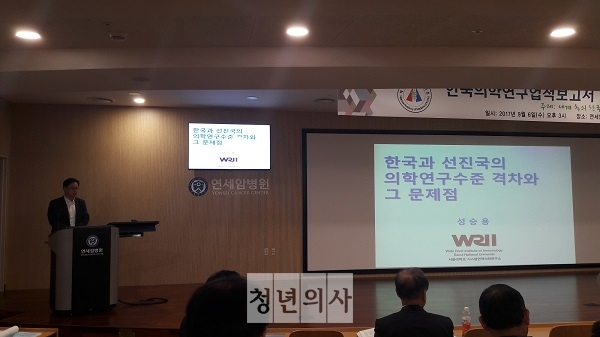Korea’s research and development projects have fallen short of attaining efficient outcome compared to the money spent on them, an expert said. It requires a comprehensive improvement by, for instance, working out long-term R&D policy and changing agencies that educate and manage them, he added.

“The government’s R&D budget can hardly be said as small compared with the nation’s economic size,” said Sung Seung-yong, director of Wide River Institute of Immunology of Seoul National University. “But the results have been meager so far. Agencies that control state budget and systems have to make more effort.”
He made these and other points at a symposium to commemorate the release of “The report of Korean medical research achievement 2015” at Yonsei Cancer Hospital 연세암병원 under the auspices of National Academy of Medicine of Korea(NAMK)대한민국의학한림원 Wednesday.
According to Sung, Korea’s R&D budget a year totaled 63 trillion won ($55.8 billion) in 2014 -- 48 trillion won from the private sector and 15 trillion won from the government and public resources.
The amount accounts for 4.29 percent of the gross domestic product, higher than Japan’s 3.59 percent, Germany’s 2.9 percent, France’s 2.26 percent, the U.K.’s 1.7 percent, China’s 2.05 percent and the U.S.’s 2.74 percent (as of 2013).
Korea has also shown the highest average growth rate of annual R&D spending from 2008 to 2014 except for China. Sung pointed out, however, the Korean R&D projects’ cost-effectiveness remains low.
The number of papers published in international journals such as Cell, Nature, and Science, from 2014 to 2016, was a mere 134, a fractional 7.3 percent of those released by the United Kingdom, which spent far less money on R&D than Korea. It means the R&D investment cost per paper published in these journals was sharply higher than that in advanced countries.
The number of newly developed drugs approved by the Ministry of Food and Drug Safety (MFDS)식품의약품안전처 also stood at only 29 from 1999 to 2017, compared with 41 new drugs approved by the U.S. Food and Drug Administration(FDA) 미국 FDA in 2014 alone.
“The government spent 1.4 trillion won on bio R&D, but I doubt whether the research results provide benefits to people,” Sung said. “The biggest problem is the research results aren’t connected to businesses.”
“Securing R&D workforces is another serious problem,” he said. “Doctors and life scientists have to cooperate for biological research, but the relationship isn’t going well. And many young researchers gave up research or went abroad and didn’t come back because of excessive adherence to short-term performance and the lack of independent research atmosphere.”
Sung noted it is necessary to make long-term R&D policy for researchers to produce results steadily.
“The government needs to work out support formula in keeping with researchers’ life cycles, and create a system to provide extensive aids on the selected workforce,” he said. “It has to protect talented researchers who can produce outcomes.”
Also needed is selecting and simplifying agencies that manage bio R&D, he stressed.
“Different government ministries are now separately managing bio R&D projects according to their stages,” Sung pointed out. “They began interagency project 10 years ago and had managed to tear down ministerial walls somewhat, but still have a long way to go. The government should allocate projects to related ministries to make their planning, outcome distribution and evaluation is made in total cycles, while the Ministry of Science and ICT(MSIT)과학기술정보통신부 controls overall procedures.”

